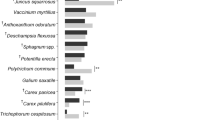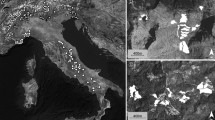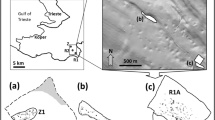Abstract
Knowledge of the ecology of pre-adult stages of an organism at its species’ range margins is a prerequisite for conserving species, especially for understanding its responses to future climate changes. Largely sedentary premature life stages require specific living conditions within a relatively small area. Such conditions are created by vegetation structure heterogeneity and a microclimate gradient, generated by varying microtopography. We investigated the microhabitat selection patterns of egg-laying females and overwintering caterpillars of peatland butterfly Coenonympha tullia relative to vegetation composition, water quantity and microclimatic conditions across microtopographic zones of transition mire at the species’ southern range margin. We showed that (1) small-scale variability in mire microtopography determines oviposition site selection and larval presence; (2) microhabitats of pre-adult stages were largely confined to the intermediate microtopographic zone of the transition mire (flats); (3) egg-laying females and overwintered larvae preferred microsites with high coverage of main hostplants (Trichophorum alpinum, Carex lasiocarpa, C. limosa, C. panicea), and those with more humid and cooler summertime conditions than on hummocks; (4) females and larvae avoided shallow hollows permanently filled with water. The vegetation structure of flats enables the females to select spots with sufficient humidity for egg development, and allows the larvae to change their location according to suitable thermal and moisture conditions. We also discuss poor prospects for species in view of impacts of future climate changes on mire ecosystems.


Similar content being viewed by others
References
Aarvik L, Hansen LO, Kononenko V (2009) Norges Sommerfugler. Håndbok over Norges dagsommerfugler og nattsvermere. Norsk entomologisk forening, Naturhistorisk museum, Universitetet i Oslo
Alexander C, Deák B, Heilmeier H (2016) Micro-topography driven vegetation patterns in open mosaic landscapes. Ecol Indic 60:906–920. https://doi.org/10.1016/j.ecolind.2015.08.030
Anthes N, Fartmann T, Hermann G, Kaule G (2003) Combining larval habitat quality and metapopulation structure—the key for successful management of pre-alpine Euphydryas aurinia colonies. J Insect Conserv 7:175–185
ARSO (2006) Podnebne razmere v Sloveniji (obdobje 1971–2000). Agencija Republike Slovenije za okolje, Ljubljana
Asher J, Warren M, Fox R, Harding P, Jeffcoate G, Jeffcoate S (2001) The millenium atlas of butterflies in Britain and Ireland. Oxford University Press, Oxford
Ashton S, Gutierrez D, Wilson RJ (2009) Effects of temperature and elevation on habitat use by a rare mountain butterfly: implications for species responses to climate change. Ecol Entomol 34:437–446. https://doi.org/10.1111/j.1365-2311.2008.01068.x
Bourn NAD, Warren MS (1997) Species Action Plan. Large Heath, Coenonympha tullia. Butterfly Conservation, Wareham, Dorset
Bragazza L (2006) A decade of plant species changes on a mire in the Italian alps: vegetation-controlled or climate-driven mechanisms? Clim Change 77:415–429. https://doi.org/10.1007/s10584-005-9034-x
Bragazza L, Buttler A, Siegenthaler A, Mitchell EAD (2008) Plant litter decomposition and nutrient release in peatlands. In: Baird AJ, Belyea LR, Comas X, Reeve AS, Slater LD (eds) Carbon cycling in Northern Peatlands. American Geophysical Union, Washington, pp 99–110
Bruland GL, Richardson CJ (2005) Hydrologic, edaphic, and vegetative responses to microtopographic reestablishment in a restored wetland. Restor Ecol 13:515–523. https://doi.org/10.1111/j.1526-100X.2005.00064.x
Bubova T, Vrabec V, Kulma M, Nowicki P (2015) Land management impacts on European butterflies of conservation concern: a review. J Insect Conserv 19:805–821. https://doi.org/10.1007/s10841-015-9819-9
Burnham KP, Anderson D (2002) Model selection and multi-model inference. A pratical information—theoretic approch. Springer, New York
Čelik T (2012) Munčev okarček, Coenonympha tullia (Müller, 1764) (Lepidoptera: Nymphalidae) v Sloveniji ni izumrl. Acta Entomologica Slovenica 20:45–58
Čelik T, Braü M, Bonelli S, Cerrato C, Vreš B, Balletto E, Stettmer C, Dolek M (2015) Winter-green host-plants, litter quantity and vegetation structure are key determinants of habitat quality for Coenonympha oedippus in Europe. J Insect Conserv 19:359–375. https://doi.org/10.1007/s10841-014-9736-3
Davenport D (1941) The butterflies of the Satyrid genus Coenonympha. Bull Mus Comp Zool Harv 87:213–424
Deák B, Valkó O, Alexander C, Mücke W, Kania A, Tamáse J, Heilmeier H (2014) Fine-scale vertical position as an indicator of vegetation in alkali grasslands—Case study based on remotely sensed data. Flora 209:693–697. https://doi.org/10.1016/j.flora.2014.09.005
Delić A, Mihoci I, Mičetić-Stanković V, Stanković I, Kučinić M (2011) Lorkovićev cretni okaš i dalje leti. Priroda 101:20–25
Dennis RLH (2012) A resource-based habitat view for conservation: butterflies in the British landscape. Wiley-Blackwell, West Sussex
Dennis RLH, Eales HT (1997) Patch occupancy in Coenonympha tullia (Müller, 1764) (Lepidoptera: Satyrinae): habitat quality matters as much as patch size and isolation. J Insect Conserv 1:167–176. https://doi.org/10.1023/A:1018455714879
Eilers S, Pettersson LB, Öckinger E (2013) Micro-climate determines oviposition site selection and abundance in the butterfly Pyrgus armoricanus at its northern range margin. Ecol Entomol 38:183–192 https://doi.org/10.1111/een.12008
Eliasson CU, Ryrholm N, Holmer M, Jilg K, Gärdenfors U (2005) Fjärilar: Dagfjärilar / Hesperiidae - Nymphalidae. Nationalnyckeln till Sveriges flora och fauna. ArtDatabanken, SLU, Uppsala
Ellenberg H (2009) Vegetation ecology of central Europe. Cambridge University Press, Cambridge
Ellenberg H, Düll R, Wirth V, Werner W, Paulißen D (1991) Zeigerwerte von Pflanzen in Mitteleuropa. Verlag Erich Goltze KG, Göttingen
Elo M, Penttinen J, Kotiaho JS (2015) The effect of peatland drainage and restoration on Odonata species richness and abundance. BMC Ecol 15:11–18. https://doi.org/10.1186/s12898-015-0042-z
Evans C, Woodin S, Lindsay R (2016) Atmospheric pollution. IUCN UK Committee Peatland Programme, Briefing Note No. 13
Fox R, Asher J, Brereton T, Roy D, Warren M (2006) The state of butterflies in Britain and Ireland. NatureBureau, Berkshire
Franco AMA, Hill JK, Kitschke C, Collingham YC, Roy DB, Fox R, Huntley B, Thomas CD (2006) Impacts of climate warming and habitat loss on extinctions at species’ low-latitude range boundaries. Glob Change Biol 12:1545–1553. https://doi.org/10.1111/j.1365-2486.2006.01180.x
Goffart P, Cavalier E, Lighezzolo P, Rauw A, Lafontaine D (2014) Restoration and management of habitat networks for Lycaena helle in Belgium. In: Habel JC, Meyer M, Schmit T (eds) Jewels in the mist: a synopsis on the endangered violet copper Butterfly Lycaena Helle, Pensoft, Sofia, pp. 197–216
Gorbunov P (2001) The butterflies of Russia: classification, genitalia, keys for identification (Lepidoptera: Hesperioidea and Papilionoidea). Russian Academy of Sciences, Institute of Plant and Animal Ecology, Ekaterinburg
Gregori J (1980) Zelenci, izvir Save Dolinke. 97. zvezek Zbirke vodnikov kulturni in naravni spomeniki Slovenije. Zavod SR Slovenije za varstvo naravne in kulturne dediščine, Ljubljana
Gunnarsson U, Malmer N, Rydin H (2002) Dynamics or constancy in Sphagnum dominated mire ecosystems? A 40-year study. Ecography 25:685–704. https://doi.org/10.1034/j.1600-0587.2002.250605.x
Gunnarsson U, Granberg G, Nilsson M (2004) Growth, production and interspecific competition in Sphagnum: effects of temperature, nitrogen and sulphur treatments on a boreal mire. New Phytol 163:349–359. https://doi.org/10.1111/j.1469-8137.2004.01108.x
Heijmans MMPD, Berendse F, Arp WJ, Masselink AK, Klees H, de Visser W, van Breemen N (2001) Effects of elevated carbon dioxide and increased nitrogen deposition on bog vegetation in the Netherlands. J Ecol 89:268–279. https://doi.org/10.1046/j.1365-2745.2001.00547.x
Heijmans MMPD, Mauquoy D, van Geel B, Berendse F (2008) Long-term effects of climate change on vegetation and carbon dynamics in peat bogs. J Veg Sci 19:307–320. https://doi.org/10.3170/2008-8-18368
Heijmans MMPD, van der Knaap YAM, Holmgren M, Limpens J (2013) Persistent versus transient tree encroachment of temperate peat bogs: effects of climate warming and drought events. Glob Change Biol 19:2240–2250. https://doi.org/10.1111/gcb.12202
Huemer P (2004) Die Tagfalter Südtirols. Folio Verlag, Wien
IPCC (2013) In: Stocker TF, Qin D, Plattner GK, Tignor M, Allen SK, Boschung J, Nauels A, Xia Y, Bex V, Midgley PM (eds) Climate Change 2013: the physical science basis. Contribution of Working Group I to the Fifth Assessment Report of the Intergovernmental Panel on Climate Change. Cambridge University Press, Cambridge
Janssen JAM, Rodwell J, Garcia Criado M, Gubby S, Haynes T, Nieto A, Sanders N, Landucci F, Loidi J, Ssymank A, Tahvanainen T, Valderrabano M, Acosta A, Aronsson M, Arts G, Attorre F, Bergmeier E, Bijlsma RJ, Bioret F, Biţă-Nicolae C, Biurrun I, Calix M, Capelo J, Čarni A, Chytrý M, Dengler J, Dimopoulos P, Essl F, Gardfjell H, Gigante D, Giusso del Galdo G, Hájek M, Jansen F, Jansen J, Kapfer J, Mickolajczak A, Molina JA, Molnár Z, Paternoster D, Piernik A, Poulin B, Renaux B, Schaminée JHJ, Šumberová K, Toivonen H, Tonteri T, Tsiripidis I, Tzonev R, Valachovič M (2016) European red list of habitats. Part 2, Terrestrial and freshwater habitats. Publication Office of the European Union
Joy J, Pullin AS (1997) The effects of flooding on the survival and behaviour of overwintering large heath butterfly Coenonympha tullia larvae. Biol Conserv 82:61–66. https://doi.org/10.1016/S0006-3207(97)00006-2
Joy J, Pullin AS (1999) Field studies on flooding and survival of overwintering Large Heath butterfly Coenonympha tullia larvae on Fenn’s and Whixall Mosses in Shropshire and Wrexham UK. Ecol Entomol 24:426–431. https://doi.org/10.1046/j.1365-2311.1999.00208.x and
Kingsolver JG, Woods HA, Buckley LB, Potter KA, MacLean HJ, Higgins JK (2011) Complex life cycles and the responses of insects to climate change. Integr Comp Biol 51:719–732. https://doi.org/10.1093/icb/icr015
Kleckova I, Klecka J (2016) Facing the Heat: Thermoregulation and Behaviour of Lowland Species of a Cold-Dwelling Butterfly Genus, Erebia. PLoS One 11:e0150393. https://doi.org/10.1371/journal.pone.0150393
Krämer B, Kämpf I, Enderle J, Poniatowski D, Fartmann T (2012) Microhabitat selection in a grassland butterfly: a trade-off between microclimate and food availability. J Insect Conserv 16:857–865. https://doi.org/10.1007/s10841-012-9473-4
Kudrna O, Pennersorfer J, Lux K (2015) Distribution atlas of European butterflies and skippers. Wissenschftlicher Verlag Peks, Schwanfeld
Lawson CR, Bennie J, Hodgson JA, Thomas CD, Wilson RJ (2014) Topographic microclimates drive microhabitat associations at the range margin of a butterfly. Ecography 37:732–740. https://doi.org/10.1111/ecog.00535
Lepš J, Šmilauer P (2003) Multivariate Analysis of Ecological data using CANOCO. Cambridge University Press, Cambridge
Limpens J, Berendse F, Klees H (2004) How phosphorus availability affects the impact of nitrogen deposition on Sphagnum and vascular plants in bogs. Ecosystems 7:793–804. https://doi.org/10.1007/s10021-004-0274-9
Lindsay R, Birnie R, Clough J (2014) Peat bog ecosystems: structure, form, state and condition. IUCN UK Committee Peatland Programme, Briefing Note No. 2
Martinčič A (1988) Flora in vegetacija barja Drni pri Zelencih. Biološki vestnik 36:19–32
Mikkola K, Spitzer J (1983) Lepidoptera associated with peatlands in central and northern Europe: a synthesis. Nota Lepidopterologica 6:216–229
Minelli A, Fusco G (2010) Developmental plasticity and the evolution of animal complex life cycles. Philos T Roy Soc B 365:631–640. https://doi.org/10.1098/rstb.2009.0268
Moeslund JE, Arge L, Bøcher PK, Dalgaard T, Svenning JC (2013) Topography as a driver of local terrestrial vascular plant diversity patterns. Nord J Bot 31:129–144. https://doi.org/10.1111/j.1756-1051.2013.00082.x
Munguira ML, Garcia-Barros E, Cano JM (2009) Butterfly herbivory and larval ecology. In: Settele J, Shreeve T, Konvička M, van Dyck H (eds) Ecology of butterflies in Europe. Cambridge University Press, Cambridge, pp 43–54
Noreika N, Kotiaho JS, Penttinen J, Punttila P, Vuori A, Pajunen T, Autio O, Loukola OJ, Kotze DJ (2015) Rapid recovery of invertebrate communities after ecological restoration of boreal mires. Restor Ecol 23:566–579. https://doi.org/10.1111/rec.12237
Noreika N, Kotze DJ, Loukola OJ, Sormunen N, Vuori A, Päivinen J, Penttinen J, Punttila P, Kotiaho JS (2016) Specialist butterflies benefit most from the ecological restoration of mires. Biol Conserv 196:103–114. https://doi.org/10.1016/j.biocon.2016.02.014
Nungesser MK (2003) Modelling microtopography in boreal peatlands: hummocks and hollows. Ecol Model 165:175–207. https://doi.org/10.1016/S0304-3800(03)00067-X
Nunner A, Bolz R (2014) Grosses Wiesenvögelchen Coenonympha tullia. In: Bräu M, Bolz R, Kolbeck H, Nunner A, Voith J, Wolf W (esds): Tagfalter in Bayern. Eugen Ulmer Verlag, Nürtingen, pp 456–459
Oliver T, Hill JK, Thomas CD, Brereton T, Roy DB (2009) Changes in habitat specificity of species at their climatic range boundaries. Ecol Lett 12:1091–1102. https://doi.org/10.1111/j.1461-0248.2009.01367.x
Pavličko A, Konvička M (2002) Okáč stříbrookỳ Coenonympha tullia (Müller, 1764). In: Beneš J, Konvička M (eds) Butterflies of the Czech Republic: Distribution and conservation II. Společnost pro ochranu motỳlů, Praha, pp 559–561
Roy DB, Thomas JA (2003) Seasonal variation in the niche, habitat availability and population fluctuations of a bivoltine thermophilous insect near its range margin. Oecologia 134:439–444. https://doi.org/10.1007/s00442-002-1121-3
Rutten G, Ensslin A, Hemp A, Fischer M (2015) Vertical and Horizontal Vegetation Structure across Natural and Modified Habitat Types at Mount Kilimanjaro. PLoS One 10(9):e0138822. https://doi.org/10.1371/journal.pone.0138822
Rydin H, Jeglum JK (2013) The biology of peatlands. Oxford University Press, Oxford
Settele J, Kudrna O, Hharpke A, Kühn I, van Swaay C, Verovnik R, Warren M, Wiemers M, Hanspach J, Hickler T, Ku¨hn E, vanHalder I, Veling K, Vliegenthart A, Wynhoff I, Schweiger O (2008) Climatic risk atlas of European butterflies. Pensoft, Sofia-Moscow
Settele J, Dover J, Dolek M, Konvička M (2009) Butterflies of European ecosystems: impact of land use and options for conservation management. In: Settele J, Shreeve T, Konvička M, van Dyck H (eds) Ecology of butterflies in Europe. Cambridge University Press, Cambridge, pp 353–370
Sijarić R (1984) Vrste roda Coenonympha Hübner u fauni Rhopalocera Jugoslavije (Lepidoptera: Satyridae). Glasnik Zemaljskog muzeja Bosne i Hercegovine, Prirodne nauke. Nova serija 23:1–106
Stuhldreher G, Fartmann T (2014) When habitat management can be a bad thing: effects of habitat quality, isolation and climate on a declining grassland butterfly. J Insect Conserv 18:965–979. https://doi.org/10.1007/s10841-014-9704-y
Stuhldreher G, Fartmann T (2015) Oviposition-site preferences of a declining butterfly Erebia medusa (Lepidoptera: Satyrinae) in nutrient-poor grasslands. Eur J Entomol 112:493–499. https://doi.org/10.14411/eje.2015.067
Suggitt AJ, Gillingham PK, Hill JK, Huntley B, Kunin WE, Roy DB, Thomas CD (2011) Habitat microclimates drive fine-scale variation in extreme temperatures. Oikos 120:1–8. https://doi.org/10.1111/j.1600-0706.2010.18270.x
Ter Braak CJF, Šmilauer P (1997–2014) Canoco 5, Windows Release 5.04. Biometris, Plant Research International, the Netherlands, and Šmilauer P, Czech republic
Tiitsaar A, Kaasik A, Lindman L, Stanevitš T, Tammaru T (2016) Host associations of Coenonympha hero (Lepidoptera: Nymphalidae) in northern Europe: microhabitat rather than plant species. J Insect Conserv 20:265–275. https://doi.org/10.1007/s10841-016-9861-2
Tshikolovets VV (2003) Butterflies of Eastern Europe. Urals and Caucasus, Brno
Turlure C, Choutt J, Baguette M, Van Dyck H (2010) Microclimatic buffering and resource-based habitat in a glacial relict butterfly: significance for conservation under climate change. Glob Change Biol 16:1883–1893. https://doi.org/10.1111/j.1365-2486.2009.02133.x
Turlure C, Radchuk V, Baguette M, Van Dyck H, Schtickzelle N (2011) On the significance of structural vegetation elements for caterpillar thermoregulation in two peat bog butterflies: Boloria eunomia and B. aquilonaris. J Therm Biol 36:173–180. https://doi.org/10.1016/j.jtherbio.2011.02.001
Turlure C, Radchuk V, Baguette M, Meijrink M, van der Burg A, WalliDeVries M, van Duinen GJ (2013) Plant quality and local adaptation undermine relocation in a bog specialist butterfly. Ecol Evol 3:244–254. https://doi.org/10.1002/ece3.427
van Swaay CAM, Warren MS, Loïs G (2006) Biotope use and trends of European butterflies. J Insect Conserv 10:189–209. https://doi.org/10.1007/s10841-006-6293-4
van Swaay CAM, Maes D, Collins S, Munguira ML, Šašić M, Settele J, Verovnik V, Warren M, Wiemers M, Wynhoff I, Cuttelod A (2011) Applying IUCN criteria to invertebrates: How red is the Red List of European butterflies? Biol Conserv 144:470–478. https://doi.org/10.1016/j.biocon.2010.09.034
van der Molen PC, Wijmstra TA (1994) The thermal regime of hummock-hollow complexes on Clara Bog, Co. Offaly. P Roy Irish Acad B 94:3: 209–221
Vilbas M, Esperk T, Edovald T, Kaasik A, Teder T (2016) Oviposition site selection of the Alcon blue butterfly at the northern range margin. J Insect Conserv 20:1059–1067. https://doi.org/10.1007/s10841-016-9939-x
Vivian-Smith G (1997) Microtopographic heterogeneity and floristic diversity in experimental wetland communities. J Ecol 85:71–82. https://doi.org/10.2307/2960628
Wainwright D, Ellis S. Large heath priority species factsheet. http://www.butterfly-conservation.org/sites/default/files/large-heath-psf.pdf
Ward G, Hastie T, Barry S, Elith J, Leathwick JR (2009) Presence-only data and the EM algorithm. Biometrics 65:554–563. https://doi.org/10.1111/j.1541-0420.2008.01116.x
Weking S, Hermann G, Fartmann T (2013) Effects of mire type, land use an climate on strongly declining wetland butterfly. J Insect Conserv 17:1081–1091. https://doi.org/10.1007/s10841-013-9585-5
Weltzin JF, Pastor J, Harth C, Bridgham SD, Updegraff K, Chapin CT (2000) Response of bog and fen plant communities to warming and water-table manipulations. Ecology 81:3464–3478. https://doi.org/10.1890/0012-9658(2000)081%5B3464:ROBAFP%5D2.0.CO;2
Weltzin JF, Bridgham SD, Pastor J, Chen J, Harth C (2003) Potential effects of warming and drying on peatland plant community composition. Glob Change Biol 9:141–151. https://doi.org/10.1046/j.1365-2486.2003.00571.x
Acknowledgements
Special thanks to two anonymous referees for their valuable comments to improve the manuscript. We thank E. Turk and F. Küzmič for the English revision of a previous version of the manuscript, and I. Sajko for making the map (Fig. 1). We are grateful to the landlords for allowing us to access the study area. Permission for the field study of C. tullia was accorded to the authors by the Ministry of the Environment and Spatial planning of Republic of Slovenia (No. 35601-140/2009–6). The study was funded by the Slovenian Research Agency (P1-0236).
Author information
Authors and Affiliations
Corresponding author
Ethics declarations
Conflict of interest
The authors declare that they have no conflict of interest.
Rights and permissions
About this article
Cite this article
Čelik, T., Vreš, B. Microtopography determines the habitat quality of a threatened peatland butterfly at its southern range margin. J Insect Conserv 22, 707–720 (2018). https://doi.org/10.1007/s10841-018-0095-3
Received:
Accepted:
Published:
Issue Date:
DOI: https://doi.org/10.1007/s10841-018-0095-3




